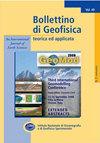Evidence of CO2-gas emission variations in the central Apennines (Italy) during the L'Aquila seismic sequence (March-April 2009)
IF 0.7
4区 地球科学
Q4 GEOCHEMISTRY & GEOPHYSICS
引用次数: 33
Abstract
The occurrence of intense CO2 degassing processes generating hundreds of cold CO2rich gas emissions is typical of the central Apennines. In 2009, significant anomalies were detected coinciding with the L’Aquila seismic sequence as a consequence of a wide degassing process. Over the same time-span, space-time anomalies in Thermal InfraRed (TIR) satellite imagery possibly related to the increase of green-house gas (such as CO2, CH4, etc.) emission rates were detected in central Italy during the seismic swarm by a Robust Satellite Technique (RST) data analysis. A gas geochemical survey carried out in the L’Aquila area confirms the deep crustal origin of the anomalous gas emission detected by ground measurements. Anomalous fluid related signals were recorded some days before the mainshock coinciding with the most marked TIR anomalies independently detected by the RST analysis over 3 different types of satellite data. Anomalous gas emissions detected by ground measurements lasted some weeks, putting in evidence relationships with crustal deformative processes associated with the seismic sequence. Together with previous ground observations in the Umbria-Marche area, present ground and satellite TIR observations, are compatible with the hypothesis that a central Apennines area, much wider than the L’Aquila (March-April 2009) epicentral one, was actually affected by anomalous increases in CO2 release thus providing new tools to better understand the processes occurring behind a seismic shock.在拉奎拉地震序列期间,亚平宁山脉中部(意大利)二氧化碳气体排放变化的证据(2009年3月- 4月)
强烈的二氧化碳脱气过程产生数百个富含二氧化碳的冷气体排放是亚平宁山脉中部的典型特征。2009年,由于大面积脱气过程,在L 'Aquila地震序列中发现了明显的异常。在相同的时间跨度内,通过鲁棒卫星技术(Robust satellite technology, RST)数据分析,在意大利中部发现了可能与地震群期间温室气体(如CO2、CH4等)排放率增加有关的热红外(TIR)卫星图像的时空异常。在拉奎拉地区进行的气体地球化学调查证实了地面测量检测到的异常气体排放的深层地壳起源。与异常流体相关的信号在主震前几天被记录下来,与RST分析在3种不同类型的卫星数据上独立检测到的最明显的TIR异常相吻合。地面测量检测到的异常气体排放持续了几个星期,提供了与地震序列相关的地壳变形过程相关的证据。结合之前在翁布里亚-马尔凯地区的地面观测,目前的地面和卫星TIR观测结果与亚平宁中部地区的假设相一致,该地区比拉奎拉(2009年3月至4月)震中更宽,实际上受到了二氧化碳释放异常增加的影响,从而为更好地理解地震冲击背后发生的过程提供了新的工具。
本文章由计算机程序翻译,如有差异,请以英文原文为准。
求助全文
约1分钟内获得全文
求助全文
来源期刊

Bollettino Di Geofisica Teorica Ed Applicata
地学-地球化学与地球物理
自引率
0.00%
发文量
0
审稿时长
>12 weeks
期刊介绍:
The "Bollettino di Geofisica Teorica ed Applicata" is an international open access journal dedicated to the publication of original papers dealing with Deep Earth Geophysics, Near Surface Geophysics, Exploration Geophysics, Borehole Geophysics, Geodynamics and Seismotectonics, Seismology, Engineering Seismology, Geophysical Modelling, Geodesy, Remote Sensing, Seismic and Geodetic Networks, Oceanography, and their application in the fields of Energy, Natural Resources, Environment and Climate, Policies and Regulations, Risk and Security, Technological Development.
 求助内容:
求助内容: 应助结果提醒方式:
应助结果提醒方式:


